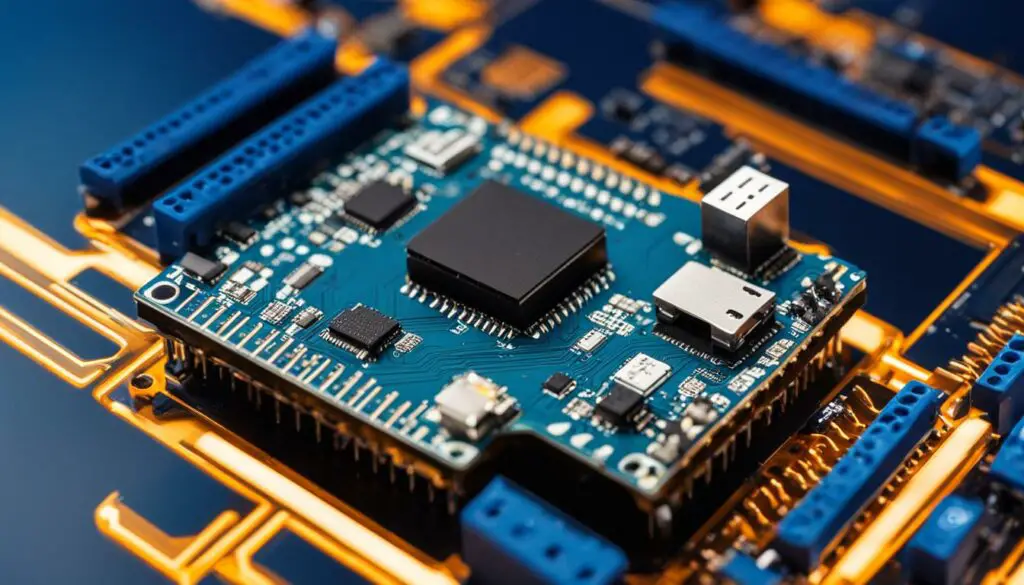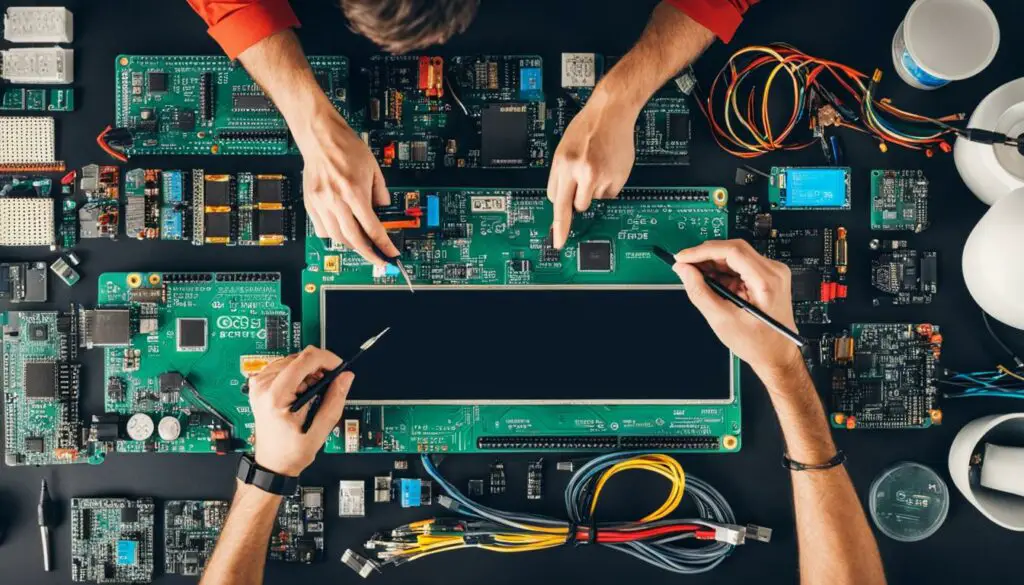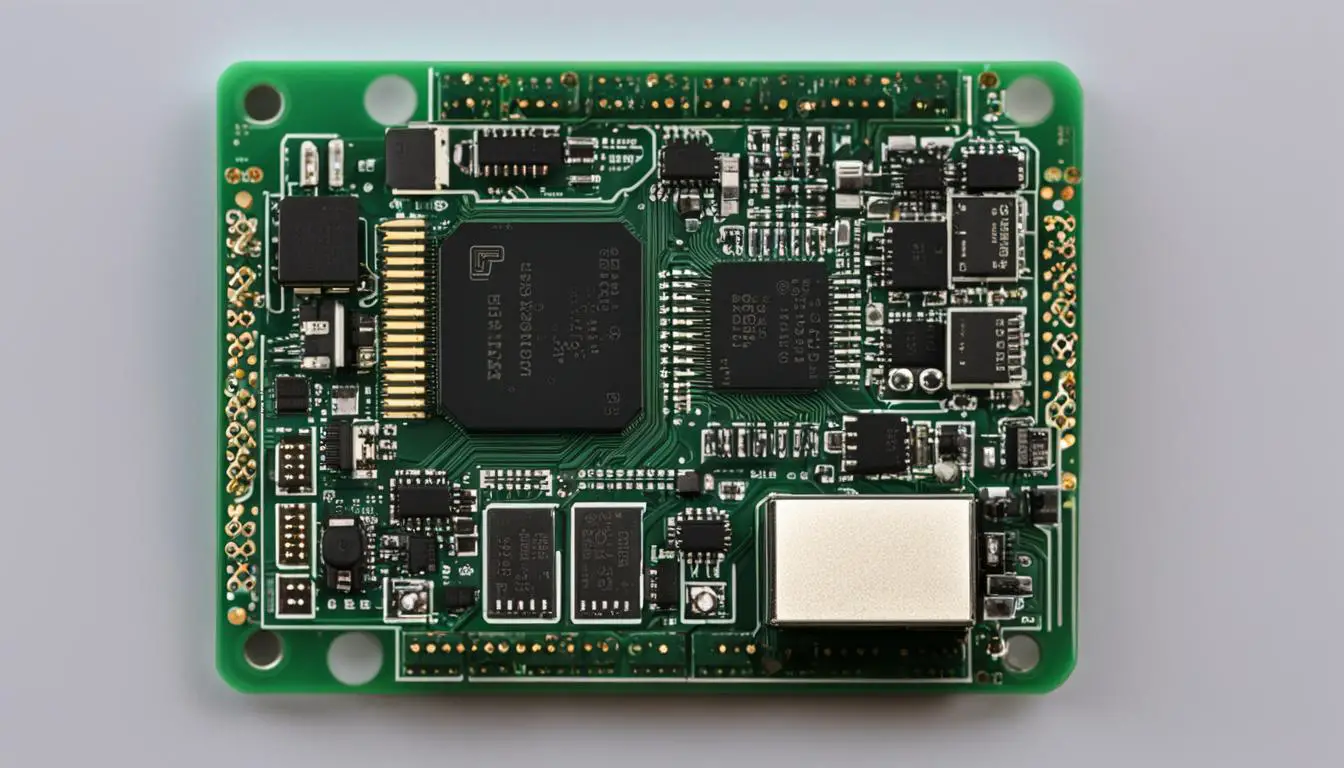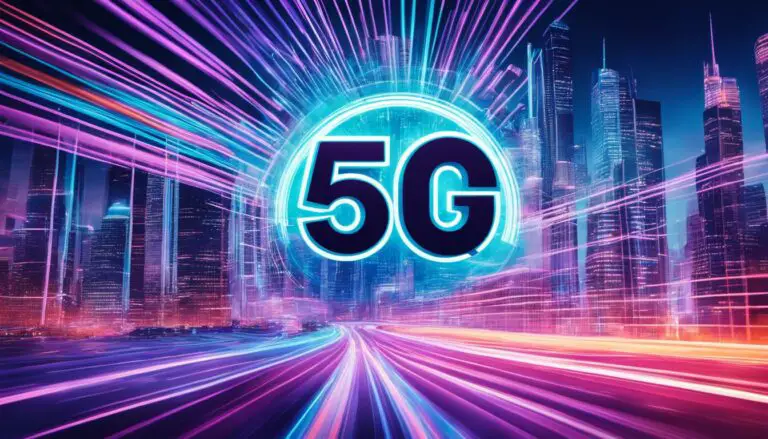Master ESP32 Arduino Projects with Ease
Originally posted on January 26, 2024 @ 4:29 pm
If you have a strong interest in IoT projects and are searching for a robust development board, the ESP32 Arduino is the perfect option for you. This board offers advanced features and is compatible with the Arduino ecosystem, providing endless possibilities for designing unique and engaging projects.
The ESP32 Arduino board combines the best of both worlds – the ESP32 microcontroller and the user-friendly Arduino IDE. With a dual-core processor, integrated Wi-Fi and Bluetooth, and a wide range of sensors, the ESP32 offers superior performance and versatility compared to other boards in the market.
Key Takeaways:
- The ESP32 Arduino is a powerful IoT board with enhanced capabilities for Arduino projects.
- The ESP32 offers a dual-core processor, integrated Wi-Fi and Bluetooth, and a wide range of sensors.
- Installing the necessary libraries and learning the basics of programming is essential to unlock the full potential of the ESP32 Arduino.
- The ESP32 Arduino provides seamless connectivity options with its integrated Wi-Fi and Bluetooth features.
- There are numerous tutorials available online to guide you through different ESP32 Arduino projects and help you get started.
ESP32 Arduino Libraries and Programming
To program the ESP32 with Arduino IDE, you need to install the necessary libraries and understand the basics of programming. The Arduino IDE provides a user-friendly interface for writing code and uploading it to the ESP32 board.
You can install the libraries required for ESP32 development from the official Expressif GitHub repository. These libraries offer a wide range of functions and examples for utilizing the various features of the ESP32, such as Wi-Fi, Bluetooth, and sensors. By leveraging these libraries, you can save time and effort in coding from scratch and focus more on implementing your project ideas.
Having access to a diverse range of libraries greatly enhances the capabilities and versatility of the ESP32. Whether you’re looking to connect to Wi-Fi networks, establish Bluetooth communication, or utilize specific sensors, the libraries provide you with the tools and resources needed to expedite development and streamline your programming process.
If you’re new to programming the ESP32 with Arduino IDE, there are plenty of online tutorials available that guide you through the process step by step. These tutorials cover various aspects of ESP32 Arduino programming, from setting up the development environment to writing and debugging your code. They also offer practical examples and insights that help you better understand the intricacies of programming the ESP32.
With the combination of Arduino IDE and the ESP32 libraries, you can easily harness the power of this IoT board and take advantage of its extensive capabilities. Whether you’re a hobbyist or a seasoned developer, the ESP32 Arduino libraries and programming environment provide a solid foundation for bringing your ideas to life.

Benefits of ESP32 Arduino WiFi:
- Easy connectivity to Wi-Fi networks
- High-speed wireless communication
- Support for 802.11 b/g/n HT40
Benefits of ESP32 Arduino Bluetooth:
- Seamless communication with Bluetooth devices
- Compatibility with both classic and BLE modes
- Wide range of applications for IoT projects
“The ESP32’s integrated Wi-Fi and Bluetooth capabilities make it a versatile choice for a variety of projects. Whether you’re building a smart home system or a wearable device, the ESP32’s connectivity options ensure seamless integration with other devices.”
ESP32 Arduino Projects and Tutorials
The ESP32 opens up a world of possibilities for Arduino projects. With its powerful processor, ample memory, and wide range of functionalities, you can create a variety of innovative projects.
Whether you’re a beginner or an experienced developer, there are numerous tutorials available online that walk you through step-by-step instructions for creating different projects with the ESP32 and Arduino IDE. These tutorials provide a great starting point, helping you understand the capabilities of the ESP32 and how to leverage them in your projects.
From home automation systems and weather stations to wireless sensor networks and robotics, the ESP32 can be used in a wide range of applications. Its flexibility and versatility make it an ideal choice for both hobbyists and professionals alike.
The Arduino IDE provides an intuitive platform for programming and uploading code to the ESP32. With its user-friendly interface, you can easily write and upload code, making it accessible to both beginners and experienced developers.
By following tutorials and harnessing the power of the ESP32 and Arduino IDE, you can bring your ideas to life and create impressive projects. Whether you want to develop a smart home solution or build a remote-controlled robot, the ESP32 offers the tools and resources you need to make it happen.
Start exploring the possibilities of ESP32 Arduino projects today and unlock your creativity in the world of IoT.

ESP32 vs Arduino Uno
When it comes to choosing between the ESP32 and Arduino Uno for your projects, there are several important factors to consider. The ESP32 offers a higher clock speed, more RAM, and integrated Wi-Fi and Bluetooth capabilities, making it a more powerful and versatile option compared to the Arduino Uno.
The ESP32’s dual-core processor allows for multitasking, making it ideal for handling complex projects that require simultaneous processing of multiple tasks. This feature sets it apart from the Arduino Uno, which has a single-core processor.
Additionally, the ESP32 provides better control of input/output operations (I/Os), allowing for greater flexibility and precision in project development. The Arduino Uno, on the other hand, is better suited for simpler projects or those that require a more straightforward and streamlined approach.
The integration of Wi-Fi and Bluetooth in the ESP32 eliminates the need for additional modules, saving both space and cost. This makes the ESP32 an excellent choice for Internet of Things (IoT) applications, where connectivity is a crucial aspect. The Arduino Uno, while capable of connecting to other devices, may require additional components for wireless communication.
The table below highlights the key features and differences between the ESP32 and Arduino Uno:
| Features | ESP32 | Arduino Uno |
|---|---|---|
| Clock Speed | Higher clock speed | Lower clock speed |
| Processor | Dual-core | Single-core |
| RAM | More RAM | Less RAM |
| Wireless Connectivity | Integrated Wi-Fi and Bluetooth | May require additional components |
| Project Complexity | More versatile for complex projects | More suitable for simpler projects |
In conclusion, while the Arduino Uno remains a popular choice for beginners and simple projects, the ESP32 offers advanced capabilities and a wider range of functionalities. Its dual-core processor, integrated Wi-Fi and Bluetooth, and superior control over I/Os make it an excellent choice for IoT applications and more complex projects. However, if simplicity and a straightforward approach are of utmost importance, the Arduino Uno still serves as a viable option.
Conclusion
The ESP32, combined with the Arduino IDE, offers a powerful platform for creating innovative IoT projects. The dual-core processor, integrated Wi-Fi and Bluetooth, and wide range of sensors make the ESP32 a top choice for developers. By following tutorials and utilizing the various libraries available, you can easily program and deploy your projects on the ESP32 Arduino IDE.
Whether you’re a beginner or an experienced developer, the ESP32 and Arduino IDE provide a user-friendly and versatile environment. The ESP32 Arduino boards provide enhanced capabilities compared to other boards in the market, allowing you to explore the full potential of your IoT projects.
Start exploring the possibilities of ESP32 Arduino projects today and unleash your creativity in the world of IoT. With the ESP32 Arduino tutorial, you can learn the essentials and quickly get started with your own projects. From home automation systems to robotic applications, the ESP32 Arduino IDE opens up a world of opportunities for your inventive ideas.
FAQ
What are the advantages of using the ESP32 for Arduino projects?
The ESP32 offers a dual-processor microcontroller, integrated Wi-Fi and Bluetooth, DAC, and various sensors, providing enhanced capabilities for IoT projects. Its dual-core processor allows for better I/O control while handling communication, and it has a wide range of functionalities and excellent power consumption.
How do I program the ESP32 with Arduino IDE?
To program the ESP32 with Arduino IDE, you need to install the necessary libraries and have a basic understanding of programming. The Arduino IDE provides a user-friendly interface for writing and uploading code to the ESP32. Libraries can be installed from the official Expressif GitHub repository, and there are numerous tutorials available online to guide you through the process.
What are the Wi-Fi and Bluetooth capabilities of the ESP32?
The ESP32 has integrated Wi-Fi and Bluetooth capabilities. Its Wi-Fi transceiver supports 802.11 b/g/n HT40, allowing for high-speed wireless communication, and it supports both classic and Bluetooth Low Energy (BLE) modes, making it compatible with a wide range of Bluetooth devices.
What kind of projects can I create with the ESP32 and Arduino IDE?
The ESP32 opens up a world of possibilities for Arduino projects. From home automation systems and weather stations to wireless sensor networks and robotics, the ESP32 can be used in a wide range of applications. There are numerous tutorials available online that provide step-by-step instructions for creating different projects with the ESP32 and Arduino IDE.
How does the ESP32 compare to the Arduino Uno?
The ESP32 offers a higher clock speed, more RAM, integrated Wi-Fi and Bluetooth, and a wider range of functionalities compared to the Arduino Uno. While the Arduino Uno is suitable for simple projects and beginners, the ESP32 provides more advanced capabilities and is better suited for IoT applications.
What makes the ESP32 and Arduino IDE a powerful combination for IoT projects?
The ESP32, combined with the Arduino IDE, offers a powerful platform for creating innovative IoT projects. With its dual-core processor, integrated Wi-Fi and Bluetooth, and a wide range of sensors, the ESP32 provides enhanced capabilities compared to other boards in the market. The Arduino IDE provides a user-friendly and versatile environment for programming and deploying projects on the ESP32.








